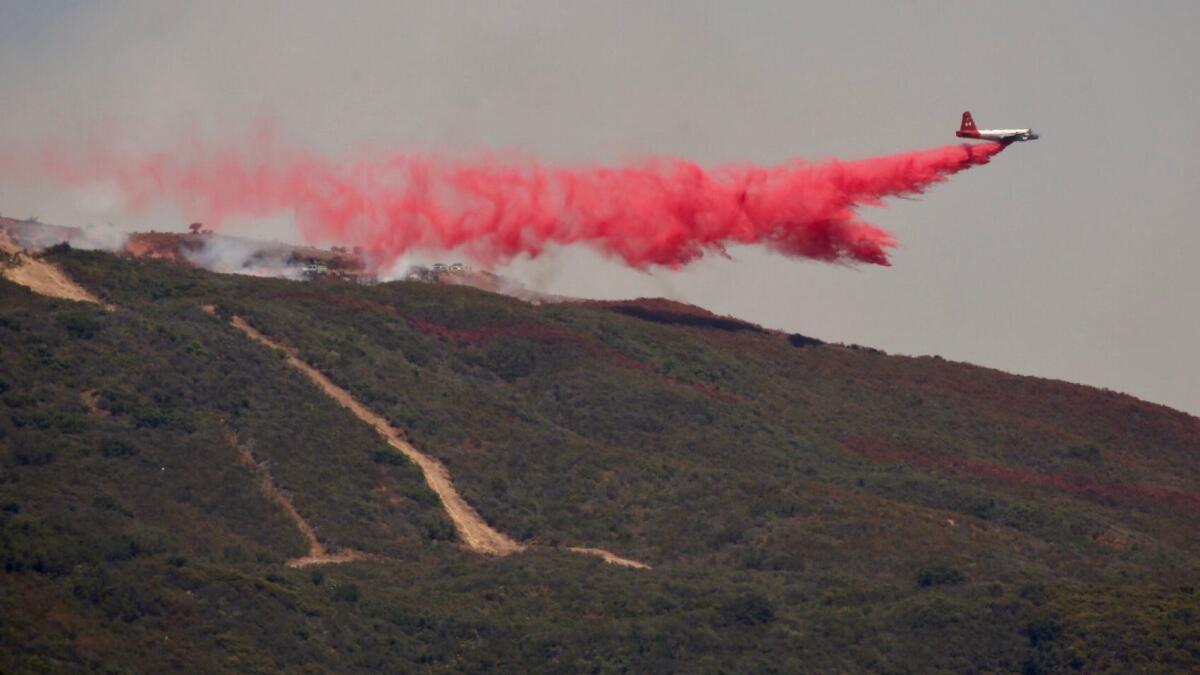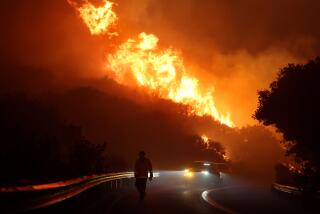The fire retardant dropped out of planes? It’s sticky, gooey and made in the Southland

It’s a sight now synonymous with California’s fire season: A tanker aircraft flies over vegetation and drops a stream of red.
But what exactly is that stuff?
It’s fire retardant, used in preemptive strikes to keep flames from spreading. Phos-Chek is by far the dominant brand and is used around homes and under fireworks displays as well as in fighting wildfires. It’s bright red for a reason, and although it’s not especially toxic, you really don’t want a plane to dump hundreds of gallons of it directly on you.
And it’s made in Southern California: in a 100,000-square-foot plant in Rancho Cucamonga, where 30 to 40 people work to produce it.
First commercialized in 1963, the powder mixture was developed by Monsanto and later approved by the U.S. Forest Service. The brand name Phos-Chek stems from its active ingredient, ammonium phosphate, and its job to check — that is, stop — fires.
See The Times’ latest information on California wildfires and how to be safe.
Unlike water or firefighting foam, the long-term fire retardant is not meant to be applied to things that are already burning. Rather, it’s used to create a chemical fire break: Once the red slurry douses vegetation, those plants won’t catch fire.
“It just deprives the fire of fuel,” said Edward Goldberg, chief executive of Phos-Chek maker Perimeter Solutions.
That vegetation remains nonflammable until a heavy rain washes off the mixture.
The fire retardant is generally safe — the Forest Service has said its risk of chemical toxicity is minor for most animals, and it predicted no risk for people who are accidentally splashed — but the sheer volume that comes out of a plane is very heavy.
“Getting hit by a 500-gallon water balloon ... that’s what it would be like to get hit by a direct drop,” said Dan Turner, executive director of Cal Poly San Luis Obispo’s Wildland-Urban Interface Fire Institute and a retired chief with the California Department of Forestry and Fire Protection, known as Cal Fire. “It’s a dangerous place to be.”
The fire retardant is gooey — sticky, even, Turner said. In his nearly four decades at Cal Fire he got doused hundreds of times. He wasn’t ever hit by that 500-gallon water balloon, but splashes did paint him and his clothes bright red.
On plants, the mixture’s red color is temporary: It disappears after a few weeks’ exposure to sunlight. But it’s important while it lasts. Pilots need to know where the retardant has landed, to make sure they form a continuous barrier.
“We’ve tried yellow, white, blue, every other color you can think of, and red is about the only thing you can see,” Goldberg said. “Everything else just blends in.”
Phos-Chek is actually a brand of multiple fire chemical products, including firefighting foams, gels and uncolored fire retardant designed for home use. But the name Phos-Chek is now so associated with the red, long-term fire retardant that’s dropped out of planes that in California, it’s used almost as a common noun, Goldberg said. It might not quite be at Kleenex level, but maybe it’s getting there.
The fire retardant had its biggest year in 2017, when Perimeter Solutions made about 50 million pounds of powder, which, when mixed with water, became 50 million gallons. That was the year severe fires burned through Napa and Sonoma counties.
Goldberg said production this year may be close to that 2017 level.
The amount used in a year is not necessarily based on how big the fires are, but rather on how much the firefighting agencies decide to rely on airdrops as part of their strategy. For example, firefighting agencies have increased their use of air tankers this year to minimize the number of firefighters on the ground so as to reduce the risk of COVID-19 transmission, Goldberg said.
The Forest Service said fire retardant is an “important tool” because it reduces the intensity and rate of a fire’s spread, enabling firefighters to access the area and start containment. Choosing when to use planes full of Phos-Chek instead of only ground crews is “not a budgetary decision,” the Forest Service said.
The Forest Service is the biggest buyer of Phos-Chek fire retardant, Goldberg said. Cal Fire is also a major customer.
Over the last 10 years, the Forest Service alone has dropped about 28 million gallons of fire retardant near wildfires nationwide to stem the spread of the fires, the agency said in an email. Fire retardant is used in only about 5% of wildfires, it said.
To make the retardant, Perimeter Solutions buys raw materials in powder form, including red coloring from a pigment company; a corrosive inhibitor that prevents the planes that drop it from getting rusty; and a thickener — similar to the one used in ice cream — that holds the fire retardant together so it doesn’t get dispersed by winds when it’s dropped from up high.
The ingredients are blended together, then milled into finer particles before they’re packaged for use at the tanker bases. One of the packaging options is a bulk bag weighing 2,000 pounds.
The powder is mixed with water at the bases to create a slurry, and then loaded into tankers for airdrops.
A Grumman S-2, one of the smaller tankers used by Cal Fire, can carry up to 1,200 gallons of fire retardant, the agency said. On the other end of the spectrum, its 747 Supertanker can carry 18,000 gallons.
Citing its status as a private company, St. Louis-based Perimeter Solutions declined to comment on its annual sales of Phos-Chek fire retardant.
But it’s got a lock on the market. The Forest Service and Cal Fire don’t use any other brand.
Last year the Forest Service spent about $23 million on fire retardant for federal lands. In 2017, Phos-Chek’s biggest year, it spent about $59 million. On average, it costs about $2.50 per gallon, the Forest Service said. (That price does not include the cost of the aircraft used to drop it.)
And it’s not just used for wildfires. Each year, Pasadena uses eight tons of an uncolored version of Phos-Chek fire retardant to protect areas with heavy vegetation around the Rose Bowl and the Arroyo Seco during its annual Fourth of July fireworks show.
Instead of being dropped from air tankers, the water and powder mixture is sprayed through a nozzle that’s connected to a water tender truck. And it works — over the last 20 years or so, “a few fires” have been kept in check by Phos-Chek, said Lisa Derderian, spokeswoman for Pasadena.
Homeowners can also get that uncolored Phos-Chek fire retardant sprayed on their property by third-party businesses such as All Risk Shield, which has been offering the service for about seven years.
Before the 2018 Woolsey fire, All Risk Shield sprayed Phos-Chek fire retardant on about a dozen customers’ properties in Malibu. All of those properties survived the fire, said Joe Torres, the Santa Monica company’s chief executive. Now about three-quarters of the company’s business is Phos-Chek application, which costs about $500 per property and lasts six to eight months, he said.
“It’s really creating that defensible space, kind of like an invisible force shield around the home,” said Chaz Castelo, co-owner of UrbnTek, a San Diego company that also offers Phos-Chek spraying services and is a partner with All Risk Shield. “It gives people the peace of mind that they’re doing something.”
More to Read
Inside the business of entertainment
The Wide Shot brings you news, analysis and insights on everything from streaming wars to production — and what it all means for the future.
You may occasionally receive promotional content from the Los Angeles Times.











